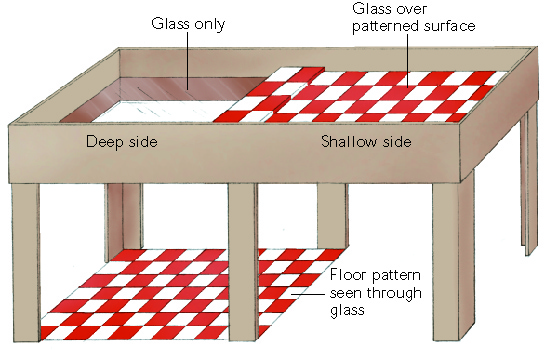I have always had lingering questions of whether I was born with fears or not? Everyone has different things that scare them more than others. For me it is heights and the thought of running into dangerous animals. Nothing is worse than climbing a ta ll building or structure to see the amazing views they may facilitate and as soon as you reach the edge you feel like your stomach just drops to the ground.
ll building or structure to see the amazing views they may facilitate and as soon as you reach the edge you feel like your stomach just drops to the ground.
Maybe even worse having the occasional thought or dream that an alligator is going to bite our leg off, while we casually swim of the shore of the Florida coast. What triggers us to have these fears when we may have never even seen an alligator before?
Visual Cliff
In 1960 two psychologists named Eleanor J. Gibson and R.D. Walk from Cornell University, set out to test the depth perception of humans and animals. They made a device that was partially connected to the table  and partly free hanging. They placed a table cloth over the table and then a piece of Plexiglas over the entire structure. It created the illusion that there was a four foot drop from the table to the floor, but in reality the piece of glass creates a stable surface area over the entire apparatus. They then placed infants who have reached the crawling faze and recorded their reaction in regards to the “visual cliff”.
and partly free hanging. They placed a table cloth over the table and then a piece of Plexiglas over the entire structure. It created the illusion that there was a four foot drop from the table to the floor, but in reality the piece of glass creates a stable surface area over the entire apparatus. They then placed infants who have reached the crawling faze and recorded their reaction in regards to the “visual cliff”.
Null Hypothesis– Humans learn to have the fear of heights
Alternate Hypothesis– Humans inherit the fear of heights from potential danger
The babies mother or caregiver would stand opposite the baby in the attempt to encourage the baby to cross over the visual cliff. According to the study, out of the 36 infants that were placed inside, 27 of them crossed to their mother. The 9 that did not cross were described as being “confused” about the drop between them and their. Even though some of them acknowledged the glass by hitting it, they still refused to cross. Being that 3/4 of the babies crossed and the other 1/4 had a fear while acknowledging the glass, enough to reject the alternate hypothesis? There may have been a third confounding variable that was unrecorded. If the babies see approval from their mother, they may lose the fear and recognize it as acceptable if their mother approves of it. The visual cliff was also tested on various animals such as kittens. In the test with kittens they recognized the cliff and potential danger, so they moved as far away into the corner they could. In this case we would be able to accept the alternate hypothesis saying newly born kittens already had the fear of heights without a third confounding variable of a mother there.
According to Nation Post, in a more recent study done by the researchers at Emory University School of Medicine in Atlanta they used mice as a subject. They would administer the smell of blossoms along with a slight electric shock. They used this so the mice would fear the smell of blossoms, because they expect to get shocked. They then used the offspring of those mice to what would happen. In fact, the study found that when the blossom smell was released for the offspring the had an increase in fear even though they had never been shocked themselves. I think this is pretty conclusive evidence but as always correlation does not equal causation.
Sources: Source 1 Source 2 Source 3

It is a really interesting topic. Actually, I have read a psychological report of that visual cliff experiment done by babies. It did gave some evidences towards questions. I have experienced fear before when I was climbing a high and steep mountain. I am more interested in how can I overcome that feeling. And I did some research about that. Here is a video that taught us how to overcome fear: https://www.youtube.com/watch?v=GDjwfFmXwfE.
This might be the most interesting topic that I have come across today. I do feel however, that this post is misleading with regards to the experiment referenced and the conclusions drawn as a result. Allow me to explain:
The visual cliff experiment (Here is a non-wikipedia source) was NOT a study that tested whether the fear of heights was inherent or learned. It was simply a study to demonstrate that many animals seem to have an inherent ability to PERCEIVE DEPTH. Depth perception does not go hand in hand with a fear of heights. I would argue that every person with properly functioning eyes can perceive depth, yet only SOME of them fear heights. Your analysis of the visual cliff does not answer the question at hand or support either hypothesis that you proposed.
Also, the babies would not have known that they still would have been supported by the glass if they crossed. If I understand correctly, adult fear of height transcends logic. Most know that they are not in danger yet they are scared regardless. This might be an interesting topic of discussion.